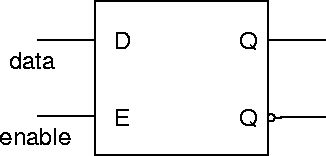 |
We now use an SR latch to build a gated D latch, Figure 59.
The operation of this latch is described by the following table:
| E | D | Qt+ | mode |
| 0 | 0 | Qt | HOLD |
| 0 | 1 | Qt | HOLD |
| 1 | 0 | 0 | RESET |
| 1 | 1 | 1 | SET |
So when the device is disabled (E=0), it holds its current value, and when enabled (E=1), it can be set or reset. I.e. E=1 implies Q=D.
A circuit implementation of the gated D latch is shown in Figure 60.
This is described by the equations

A waveform illustrating the operation of the gated D latch is shown in Figure 61.
Note that Q responds to changes in D while E is active - this is called transparency.
By connecting E to a clock signal, this device could be used as a level triggered flip flop.
However, level trigger FFs are not often used because of transparency and other problems.
ANU Engineering - ENGN3213